horn TOYOTA 4RUNNER 2022 Owners Manual
[x] Cancel search | Manufacturer: TOYOTA, Model Year: 2022, Model line: 4RUNNER, Model: TOYOTA 4RUNNER 2022Pages: 616, PDF Size: 12.01 MB
Page 155 of 616
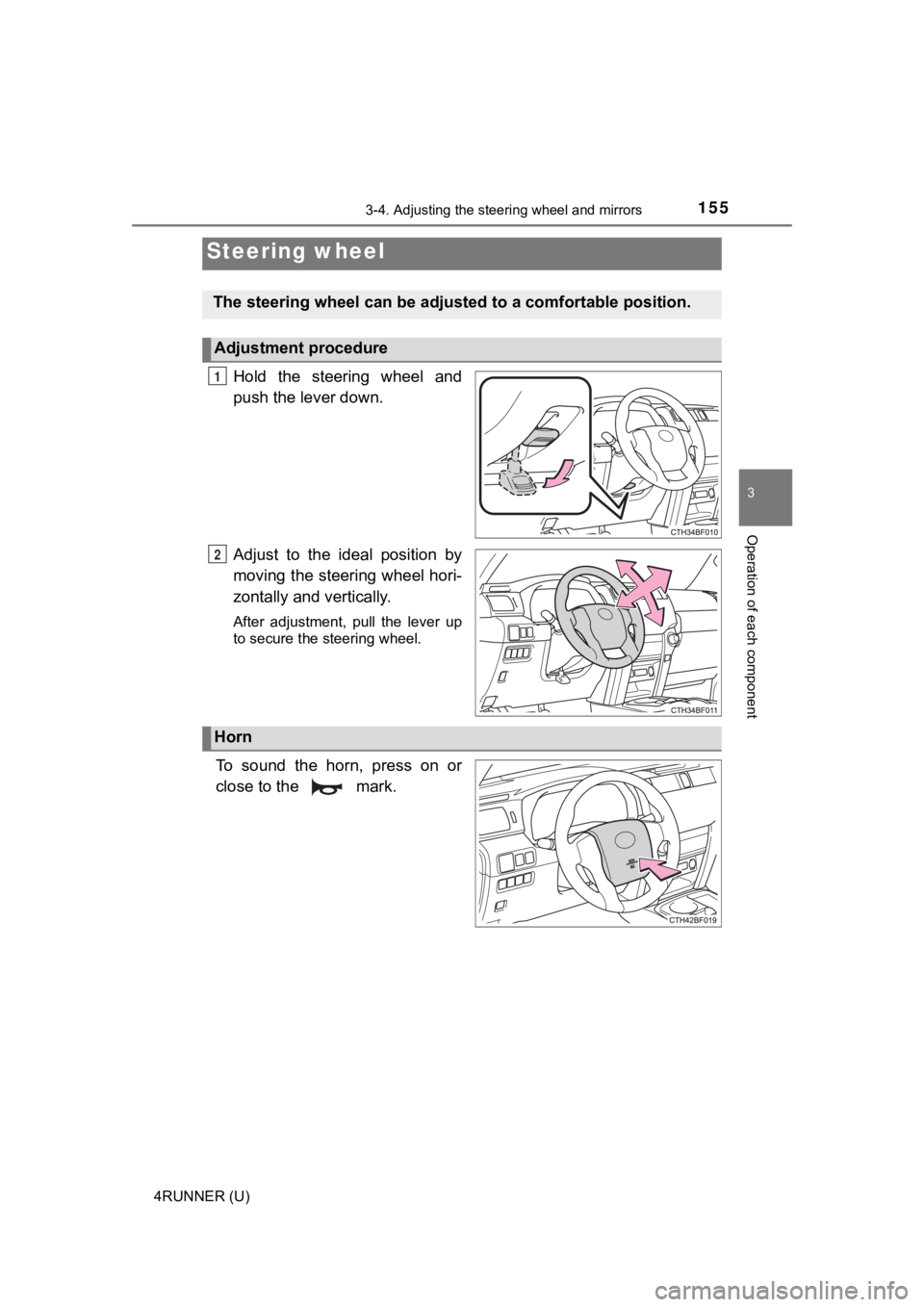
155
3
Operation of each component
4RUNNER (U)
3-4. Adjusting the steering wheel and mirrors
Hold the steering wheel and
push the lever down.
Adjust to the ideal position by
moving the steering wheel hori-
zontally and vertically.
After adjustment, pull the lever up
to secure the steering wheel.
To sound the horn, press on or
close to the mark.
Steering wheel
The steering wheel ca n be adjusted to a comfortable position.
Adjustment procedure
1
2
Horn
Page 156 of 616

1563-4. Adjusting the steering wheel and mirrors
4RUNNER (U)
WARNING
■Caution while driving
Do not adjust the steering wheel while driving.
Doing so may cause the driver to mishandle the vehicle and caus e an acci-
dent, resulting in death or serious injury.
■ After adjusting the steering wheel
Make sure that the steering wheel is securely locked.
Otherwise, the steering wheel may move suddenly, possibly causi ng an
accident, and resulting in death or serious injury. Also, the horn may not
sound if the steering wheel is not securely locked.
Page 293 of 616
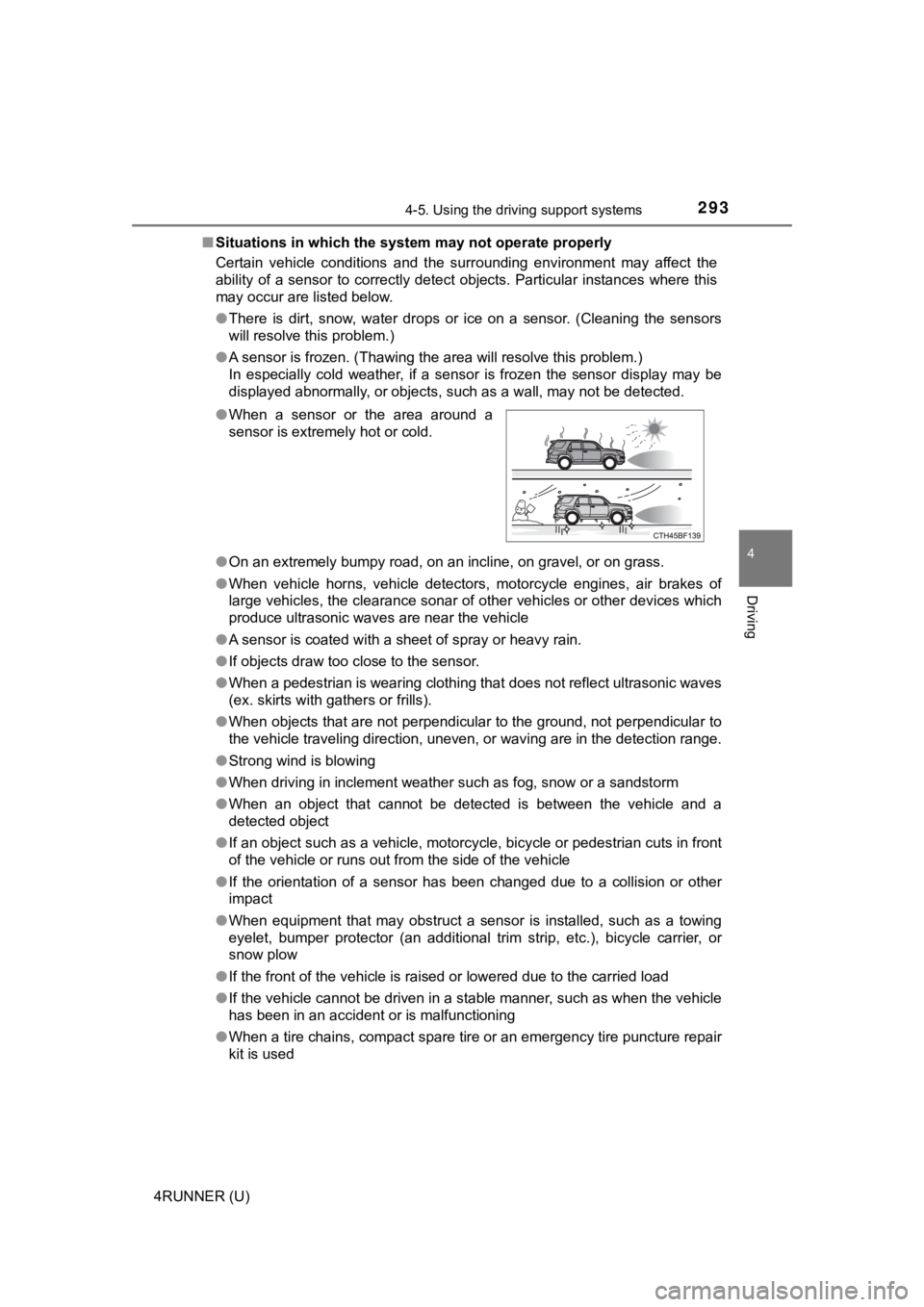
2934-5. Using the driving support systems
4
Driving
4RUNNER (U)■
Situations in which the syst em may not operate properly
Certain vehicle conditions and the surrounding environment may affect the
ability of a sensor to correctly detect objects. Particular instances where this
may occur are listed below.
● There is dirt, snow, water drops or ice on a sensor. (Cleaning the sensors
will resolve this problem.)
● A sensor is frozen. (Thawing t he area will resolve this problem .)
In especially cold weather, if a sensor is frozen the sensor di splay may be
displayed abnormally, or objects, such as a wall, may not be detected.
● On an extremely bumpy road, on an incline, on gravel, or on grass.
● When vehicle horns, vehicle detectors, motorcycle engines, air brakes of
large vehicles, the clearance sonar of other vehicles or other devices which
produce ultrasonic waves are near the vehicle
● A sensor is coated with a sheet of spray or heavy rain.
● If objects draw too close to the sensor.
● When a pedestrian is wearing clothing that does not reflect ult rasonic waves
(ex. skirts with gathers or frills).
● When objects that are not perpendicular to the ground, not perpendicular to
the vehicle traveling direction, uneven, or waving are in the d etection range.
● Strong wind is blowing
● When driving in inclement weather such as fog, snow or a sandst orm
● When an object that cannot be detected is between the vehicle a nd a
detected object
● If an object such as a vehicle, motorcycle, bicycle or pedestrian cuts in front
of the vehicle or runs out from the side of the vehicle
● If the orientation of a sensor has been changed due to a collis ion or other
impact
● When equipment that may obstruct a sensor is installed, such as a towing
eyelet, bumper protector (an additional trim strip, etc.), bicy cle carrier, or
snow plow
● If the front of the vehicle is raised or lowered due to the car ried load
● If the vehicle cannot be driven in a stable manner, such as whe n the vehicle
has been in an accident or is malfunctioning
● When a tire chains, compact spare tire or an emergency tire pun cture repair
kit is used
●
When a sensor or the area around a
sensor is extremely hot or cold.
Page 294 of 616
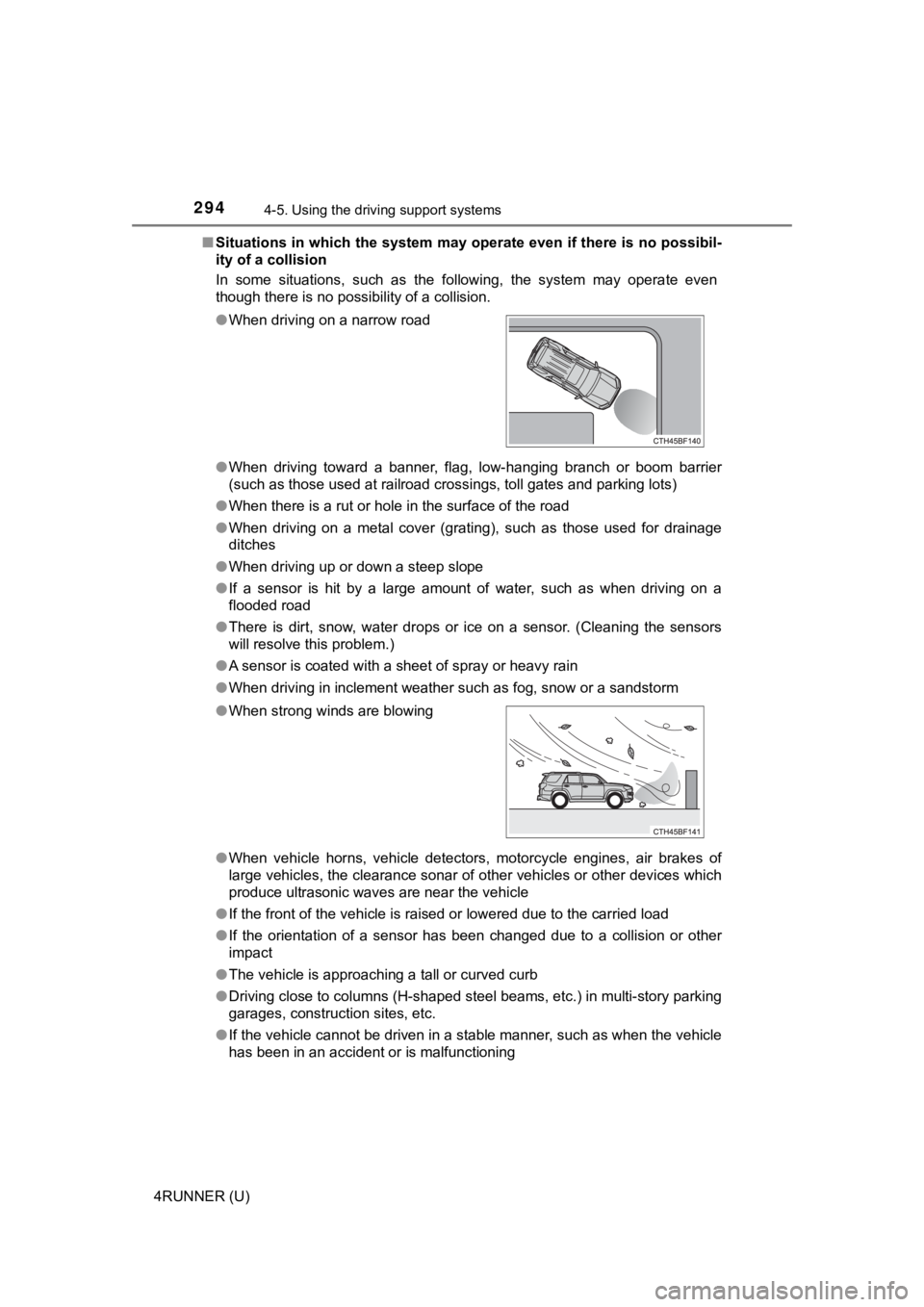
2944-5. Using the driving support systems
4RUNNER (U)■
Situations in which the system may operate even if there is no possibil-
ity of a collision
In some situations, such as the following, the system may opera te even
though there is no possibility of a collision.
● When driving toward a banner, flag, low-hanging branch or boom barrier
(such as those used at railroad crossings, toll gates and parking lots)
● When there is a rut or hole in the surface of the road
● When driving on a metal cover (grating), such as those used for drainage
ditches
● When driving up or down a steep slope
● If a sensor is hit by a large amount of water, such as when dri ving on a
flooded road
● There is dirt, snow, water drops or ice on a sensor. (Cleaning the sensors
will resolve this problem.)
● A sensor is coated with a sheet of spray or heavy rain
● When driving in inclement weather such as fog, snow or a sandst orm
● When vehicle horns, vehicle detectors, motorcycle engines, air brakes of
large vehicles, the clearance sonar of other vehicles or other devices which
produce ultrasonic waves are near the vehicle
● If the front of the vehicle is raised or lowered due to the car ried load
● If the orientation of a sensor has been changed due to a collis ion or other
impact
● The vehicle is approaching a tall or curved curb
● Driving close to columns (H-shaped steel beams, etc.) in multi- story parking
garages, construction sites, etc.
● If the vehicle cannot be driven in a stable manner, such as whe n the vehicle
has been in an accident or is malfunctioning
●
When driving on a narrow road
● When strong winds are blowing
Page 517 of 616
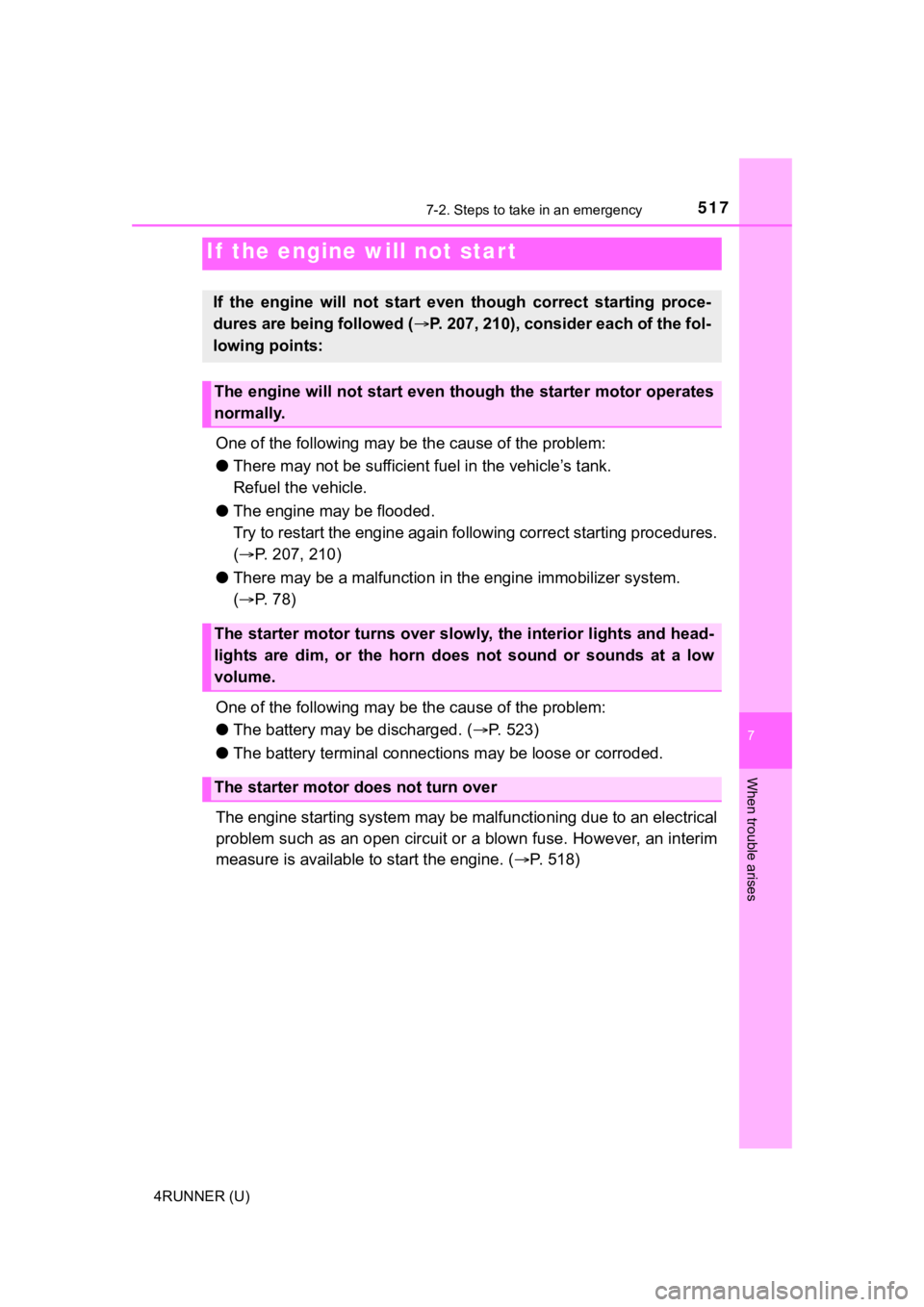
5177-2. Steps to take in an emergency
7
When trouble arises
4RUNNER (U)
One of the following may be the cause of the problem:
● There may not be sufficient fuel in the vehicle’s tank.
Refuel the vehicle.
● The engine may be flooded.
Try to restart the engine again following correct starting proc edures.
( P. 207, 210)
● There may be a malf unction in the engine immobilizer system.
( P. 78)
One of the following may be the cause of the problem:
● The battery may be discharged. ( P. 523)
● The battery terminal connecti ons may be loose or corroded.
The engine starting system may be malfunctioning due to an elec trical
problem such as an open circuit or a blown fuse. However, an in terim
measure is available to start the engine. ( P. 518)
If the engine will not star t
If the engine will not start eve n though correct starting proce -
dures are being followed ( P. 207, 210), consider each of the fol-
lowing points:
The engine will not start even t hough the starter motor operates
normally.
The starter motor turns over slowly, the interior lights and he ad-
lights are dim, or the horn does not sound or sounds at a low
volume.
The starter motor d oes not turn over
Page 518 of 616
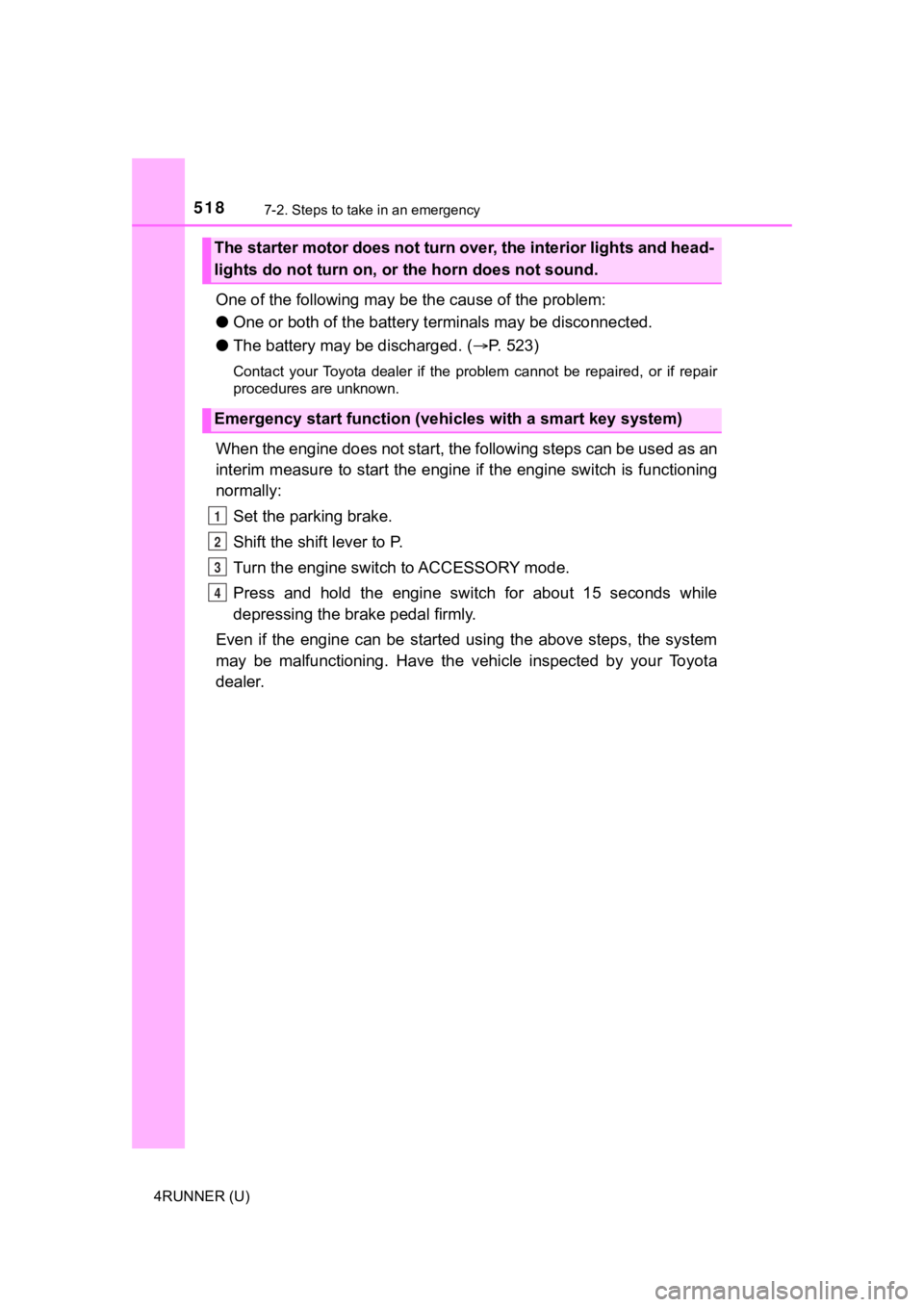
5187-2. Steps to take in an emergency
4RUNNER (U)
One of the following may be the cause of the problem:
● One or both of the battery t erminals may be disconnected.
● The battery may be discharged. ( P. 523)
Contact your Toyota dealer if the problem cannot be repaired, o r if repair
procedures are unknown.
When the engine does not start, the following steps can be used as an
interim measure to start the engine if the engine switch is fun ctioning
normally:
Set the parking brake.
Shift the shift lever to P.
Turn the engine switch to ACCESSORY mode.
Press and hold the engine switch for about 15 seconds while
depressing the brake pedal firmly.
Even if the engine can be start ed using the above steps, the sy stem
may be malfunctioning. Have the vehicle inspected by your Toyot a
dealer.
The starter motor does not turn over, the interior lights and h ead-
lights do not turn on, o r the horn does not sound.
Emergency start function (vehicles with a smart key system)
1
2
3
4
Page 589 of 616
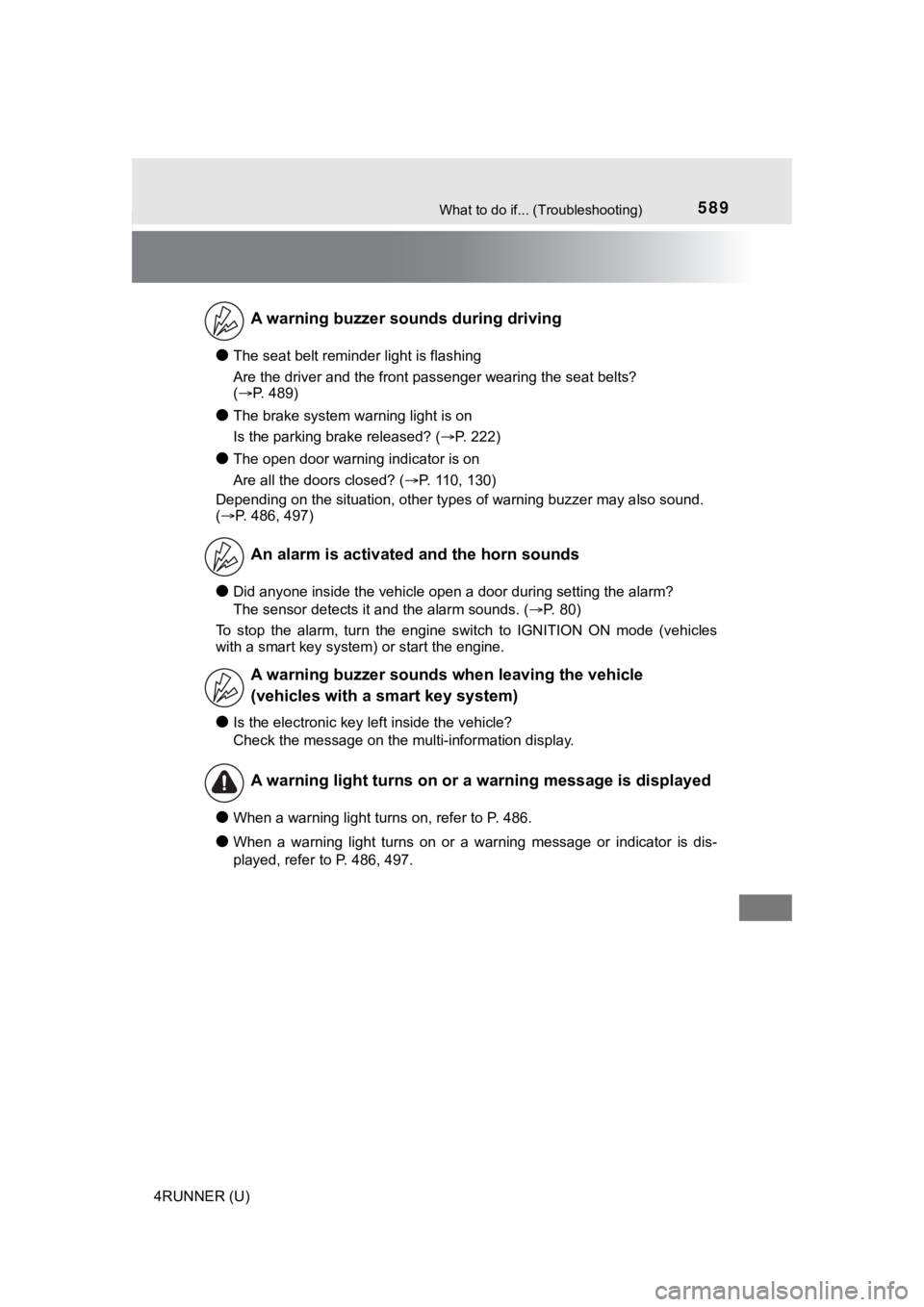
589What to do if... (Troubleshooting)
4RUNNER (U)
●The seat belt reminder light is flashing
Are the driver and the front passenger wearing the seat belts?
(P. 489)
●The brake system warning light is on
Is the parking brake released? ( P. 222)
●The open door warning indicator is on
Are all the doors closed? (P. 110, 130)
Depending on the situation, other types of warning buzzer may a lso sound.
( P. 486, 497)
●Did anyone inside the vehicle open a door during setting the al arm?
The sensor detects it and the alarm sounds. ( P. 80)
To stop the alarm, turn the engine switch to IGNITION ON mode ( vehicles
with a smart key system) or start the engine.
●Is the electronic key left inside the vehicle?
Check the message on the multi-information display.
●When a warning light turns on, refer to P. 486.
●When a warning light turns on or a warning message or indicator is dis-
played, refer to P. 486, 497.
A warning buzzer sounds during driving
An alarm is activated and the horn sounds
A warning buzzer sounds w hen leaving the vehicle
(vehicles with a smart key system)
A warning light turns on or a warning message is displayed
Page 595 of 616

595Alphabetical index
4RUNNER (U)
Fog lights ................................. 232Replacing light bulbs............. 462
Switch ................................... 232
Wattage ................................ 541
Four-wheel drive
system ............................ 305, 309
Front passenger occupant classification system .............. 48
Front personal lights ............... 370
Front seats ............................... 135 Adjustment ............................ 135
Cleaning................................ 408
Correct driving posture ........... 30
Driving position memory ....... 148
Head restraints ..................... 152
Seat heaters ......................... 367
Seat position memory ........... 148
Seat ventilators ..................... 367
Front side marker lights.......... 223 Light switch ........................... 223
Replacing light bulbs............. 467
Wattage ................................ 541
Front turn signal lights ........... 221
Replacing light bulbs............. 465
Turn signal lever ................... 221
Wattage ................................ 541
Fuel ........................................... 240
Capacity ................................ 534
Fuel gauge .............................. 90
Fuel pump shut off system.... 485
Information ............................ 542
Refueling............................... 240
Type .............................. 240, 534
Warning light ......................... 489
Fuel filler door.......................... 240 Refueling............................... 240
Fuel pump shut off system ..... 485
Fuses ........................................ 459 Garage door opener ................ 396
Gauges ....................................... 90
Glove box ................................. 373
Grocery bag hooks.................. 382
Head restraints ........................ 152
Headlights ................................ 223
Automatic High Beam
system .......... ...................... 228
Light switch ........................... 223
Replacing light bulbs .... 464, 472
Wattage ................................ 541
Heaters Air conditioning
system ....... ................. 352, 359
Outside rear view mirrors ....................... 354, 361
Seat heaters ......................... 367
Hill-start assist control ........... 334
Hood ......................................... 420
Hooks Cargo hooks ......................... 379
Cargo net hooks ................... 380
Grocery bag hooks ............... 382
Retaining hooks (floor mat) .... 28
Horn .......................................... 155G
H